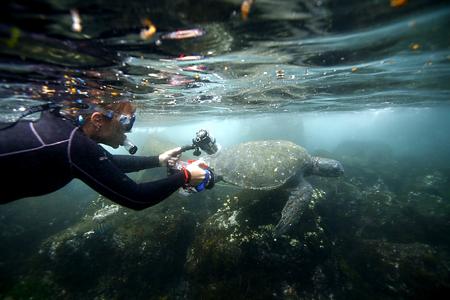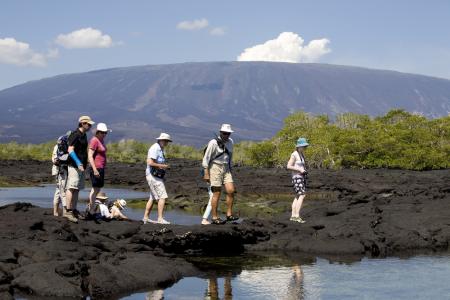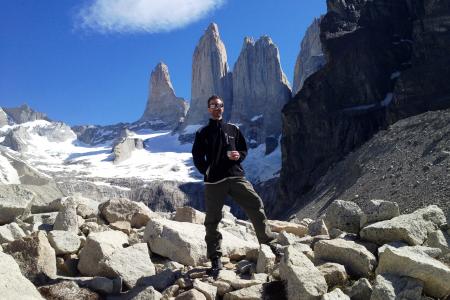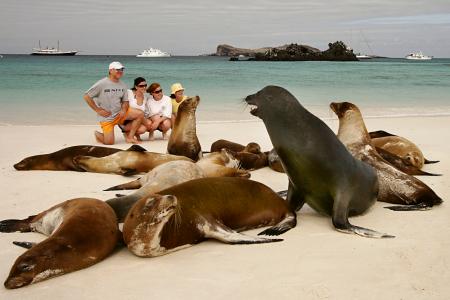Unique wildlife and dramatic landscapes at Galapagos Islands
More than one fifth of the marine species in the Galapagos are not found anywhere else in the world
He was 15 years old when he made his first trip to the Galapagos Islands, thanks to a surprise treat from his parents.
It was 1989, and the nature enthusiast quickly fell in love with the unique biodiversity that was on offer.
That vacation was a life-changing experience for tour operator Quasar Expeditions' sales manager Eric Andrews, who became a marine biologist and later, a dive guide and cruise director with the company.
"The Galapagos Islands are so authentic and raw, with extraordinary wildlife that are oblivious to your presence.
"For me, there is no other place on earth which offers a diversity of wildlife that (behaves this way)," the 43-year-old, who was born in Ecuador, told The New Paper in an e-mail interview.
The Galapagos, an archipelago of 20 islands in the Pacific Ocean, located some 1,000km from the coast of Ecuador, is home to marine iguanas, giant tortoises and Darwin's finches.
The finches, collected by Charles Darwin in 1835, played a major part in his coming up with the theory of evolution by natural selection.
More than 20 per cent of the marine species in the Galapagos are not found anywhere else on the planet.
CRUISES
Travellers craving to be one with nature will find the Galapagos Islands to be a dream destination unlike any other.

Quasar Expeditions offers cruises and private charters to the Galapagos Islands, with prices that start from US$5,780 (S$8,030) per person, excluding international flights.
One can also choose to see neighbouring Peru at an additional cost.
Travellers can look forward to admiring dramatic views, snorkelling in crystal clear waters alongside various types of marine life, kayaking beside the walls of a sunken caldera, swimming in a grotto, hiking along cliffs and on lava fields, and more.

"In Ecuador, we have a saying that translates into: 'You have to shake hands with the town (when you travel)'.
"At Quasar Expeditions, we do not follow a 'cookie-cutter' approach and hence, these trips are perfect for well-travelled Singaporeans," said Mr Andrews.
Through its cruises, the tour operator aims to educate travellers about the Galapagos Islands, which also face the impact of global warming.

Other threats include over-population, over-fishing and sustainability challenges as the result of politics. Quasar Expeditionsworks closely with other tour operators as well as organisations like the Galapagos National Park, the Galapagos Conservancy and World Wildlife Fund in conservation efforts.
For example, Quasar Expeditions founded the Galapagos Scouts Project in 1997, supporting scouts in their vision of "making a true contribution for the creation of a better world" and providing them with help and resources to tackle the challenges that threaten their future on the islands.
On top of that, tourism also contributes towards conservation efforts.
"Having travellers visit the Galapagos is actually a key element in making sure the islands are conserved.
"To work, operators on the islands must follow regulations, apply conservation-oriented procedures and be respectful of all the islands. This, in turn, allows travellers to learn about the islands and educates them on what is being done right and what can be improved on.
"It helps to get the word out and helps the islands obtain continuous support," said Mr Andrews.
Ask Mr Andrews about his fondest Galapagos memory and he has trouble choosing just one.
But one of the many was his time at Gardner Bay beach, a pristine, white-powdered beach located on Espanola Island and home to a large colony of sea lions.
"I was lying on the beach taking photos when suddenly, I felt a heavy weight at my feet. It was a young female sea lion who had just gotten out of the water.
"Maybe she thought I looked nice and warm so she lay on top of my legs to cuddle and warm up. Needless to say, that sight became the spectacle of the moment," he recalled.
Tips for travellers
- The Galapagos is one of the largest marine reserves in the world, so set aside a reasonable amount of time to visit the islands.
- A cruise, rather than a land-based tour, is recommended. This allows visitors to explore the more remote areas of the Galapagos. It is also more value for the time and money spent.
- Follow all rules and regulations. Not doing so can cause severe damage to the islands.
- Find a travel agent or tour operator that is knowledgeable. A trip to the Galapagos Islands is not one that you can DIY. A2A Journeys, Quasar Expeditions’ partner in Singapore, can work with travellers to plan a trip catered to their needs.
- Pack what you need. This includes sturdy and comfortable footwear, a waterproof day pack, snorkelling gear and wetsuits.
Get The New Paper on your phone with the free TNP app. Download from the Apple App Store or Google Play Store now


